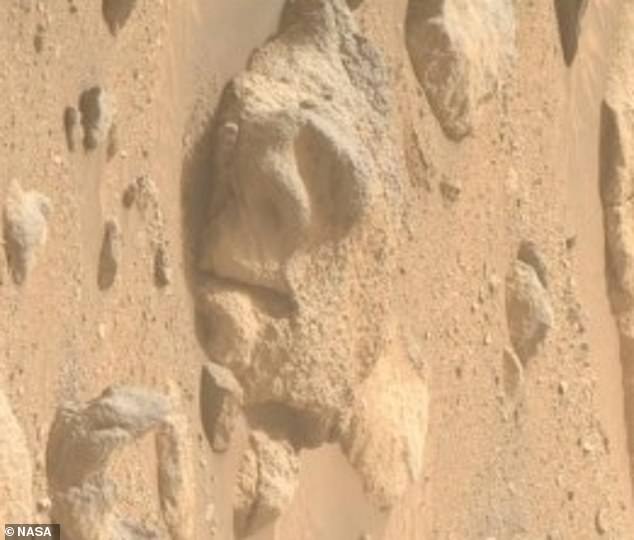NASA sees rock on Mars with a human-like face – can YOU see it?
NASA’s Mars rover has discovered a strange rock in the Martian landscape that appears to have a human face.
At the far left of the photo, an oddly shaped rock looks like a slightly squashed head lying on its side, with prominent features including eyes, a nose and a mouth.
The rock has a tired, listless expression and combined with its horizontal position, it looks like this Martian face has just given up.
The Perseverance rover photographed the bizarre sight on September 27 as it made its way through Jezero Crater, a 28-mile-wide area on Mars that may once have been underwater.
NASA’s Perseverance Mars rover captured a photo of a rock resembling a human face (left) on the red planet’s surface
Perseverance – a remote-controlled mobile laboratory the size of a car – has been exploring the dusty basin of this asteroid impact site since February 2021.
Jezero once flowed with water some 3.7 billion years ago, with evidence of a ‘paleola lake’ and a long, lost river delta within the rim of this 45 kilometer diameter crater.
The mission is for the rover to look for ancient rocks that could provide insight into the early history of Mars.
Perseverance took this photo using the Right Mastcam-Z camera, a pair of cameras located high on the rover’s mast, according to NASA.
Mastcam-Z offers a quality of 2 megapixels, ‘similar to that of a consumer digital camera’, according to the specifications of the US space agency, which explains the clear image of this rock formation.
Seeing faces in inanimate objects is a common psychological phenomenon known as pareidolia, an illusion that occurs when people see a meaningful image in a random or ambiguous visual pattern.
This isn’t the first time one of NASA’s Mars rovers has encountered familiar shapes while exploring the planet’s terrain.
Earlier this month, the rover discovered a zebra-striped rock that the mission team named Freya Castle after the peak in the Grand Canyon.
“Since Freya Castle is a loose rock that is distinctly different from the underlying bedrock, it likely ended up here somewhere else,” NASA said.
Freya Castle measures about eight inches in diameter, and early interpretations of its unique texture suggest that igneous and/or metamorphic processes could have created the streaks, NASA wrote in a statement.
Igneous processes are geological activities associated with the melting, movement and cooling of magma and lava.
Magma is molten rock that is below the planetary surface, while lava is molten rock that is above the Earth’s surface.

The rock has a tired, listless expression and combined with its horizontal position, it looks like this Martian face has just given up
For a billion years, Mars was a very volcanically active planet, which could have created the conditions necessary for zebra rock to form.
The rover was navigating through “stealthy” terrain when NASA scientists on Earth spotted the zebra stone sticking out against the planet’s dusty red surface.
Because Freya Castle is a loose rock and clearly does not match the underlying Martian bedrock, NASA experts think it could have come from somewhere else – perhaps rolled downhill from a higher source.
“This possibility excites us, and we hope that as we continue uphill, Perseverance will encounter an outcrop of this new rock type so that more detailed measurements can be obtained,” NASA said.
Mars borders the main asteroid belt and its atmosphere is only one percent as thick as Earth’s. That means it’s often bombarded by space rocks, which infiltrate the Martian atmosphere unscathed and land largely intact.
But the majority of rocks found on Mars’ surface were formed by volcanic activity, wind erosion, and ancient water flows that have dried up.
